LEUCOPHAEUS ATRICILLA: LAUGHING STOCK ON ABACO
Photos & vid, Keith Salvesen; Joke, most people on Earth (though not with illustrative pics)

When I first got a GoPro, I made a mistake. What I really needed was a GoAm. My level of sophistication in Camera-world lines up just above the ‘incompetent’ mark. So, in taking footage of a partial sperm whale skeleton on the sea floor in Abaco last week, I have found several total duds – as if I have confused the ‘take’ button with the ‘on-off’ button. Indeed, as I obviously did.
These photographic deficiencies are matched by my well-documented feeble swimming skills that improve only slightly with a snorkel and mask. And I am not legally permitted within 25 metres of Scuba equipment in all but landlocked countries.
The footage of the whale skeleton worked out quite well in the end, considering the directional uncertainties caused by my swimming technique. In trimming the ends, I found I had taken quite a lot of underwater footage directed upwards to the surface rather than downwards on the cetacean remains. Probably, I was gasping for air.
I’m not sure that any of these stills count as photography at all. But as my finger hovered over the trashcan sign, it crossed my mind that there was (possibly) a strange beauty in these random outtakes. So I clipped and cropped to see how that might work. I wait to see the feedback (if any). If my number of followers drops below 50%, I will have to delete the dross swiftly, with due apologies.
I’ll be posting the story behind the sperm whale skeleton in due course. Meanwhile, these clips are an interim curiosity. And that’s probably putting it at its highest…
All photos taken at Sandy Point, Abaco Bahamas – Keith Salvesen / Rolling Harbour

I’m just back from Abaco. Mostly, it was about Marine Mammals (i.e. whales, dolphins, manatees) and the biennial Retreat for the Bahamas Marine Mammal Research Organisation (BMMRO). There was still time for some birding in Sandy Point, though. It’s a good place at any time for bird-watching BUT the settlement is rather remote. Specifically it is the terminus of the single 120-mile Highway that stretches south from Little Abaco in the north. Then the tarmac abruptly runs out and gives way at once to white sand. If that doesn’t halt you, you’ll wish your vehicle was amphibious…
Loggerhead kingbirds, with their hooky flycatcher beaks, cresty hair and dashing yellowish undersides, are intriguing companions. If they get interested in you (or maybe your camera bleep, as I have discovered), they will accompany you on a walk, flying ahead until you catch up, then doing it again. And if they are ‘hawking’ for flies from a favourite perch, they are fun to watch and… a big bonus… they won’t stop because you are spectating.
Like all the Bahamas flycatchers, from the little cuban pewee upwards, the Kingbirds have a charming way of cocking their head to one side or dropping it down towards their chest. Slightly posey, always endearing.
OPTIONAL MUSICAL DIGRESSION
‘Bird on the Wire’ was originally sung by Judy Collins, though written by Leonard Cohen. His own definitive version from 1968’s ‘Songs from a Room‘ is arguable the best known recording and preceded several hundred later cover versions. LC is a really “difficult” artist, however. Many will agree with his expressed view that the song is ‘a prayer and an anthem’. Others might say that it is simply growly dirge-like maundering. The (then-modish) mouth-harp twangling in the background may also be an opinion-divider. Since I have shoehorned Cohen’s song title into my blog title, you might as well have the song too, for contemplation. Is it a life-affirming ‘upper’ or a funereal ‘downer’? You be the judge!
Photos: Keith Salvesen / Rolling Harbour, Sandy point, Abaco.
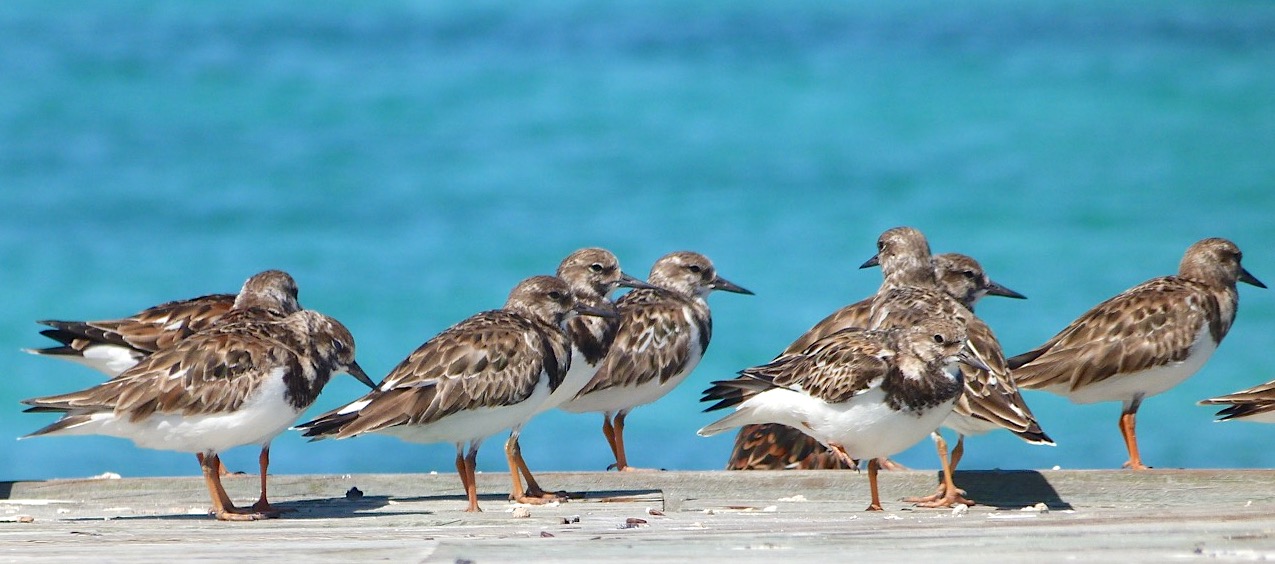
I’ve been checking out jetties at Sandy Point, of which there are several. They look a bit rickety but are in fact sound except for having to step rounds piles of (empty) conch shells and occasional evidence on the timbers of recent fish-cleaning. This is a time of Laughing Gulls, and I have been recording their raucous hilarity. I may add a couple of sound files when I’ve downloaded them.
Sharing a joke
Right now, ruddy turnstones and laughing gulls seems to have formed a team of jetty birds, with a few royal terns in the mix and (as here) a random sanderling. The turnstones like to lie down in the hot sun on the jetty, possibly because it’s a bit breezier than on the burning sand of the beach.
Exhausted from turning stones
The jetties also attract pelicans, which use them to sun themselves and also to fish from. I will post about these remarkable birds another time. The largest flock of them I have seen so far is 5, one with a gold ‘breeding crown’.


The gulls also spend time on the beach, and flock on the sandbars that emerge at low tide
All photos: Keith Salvesen
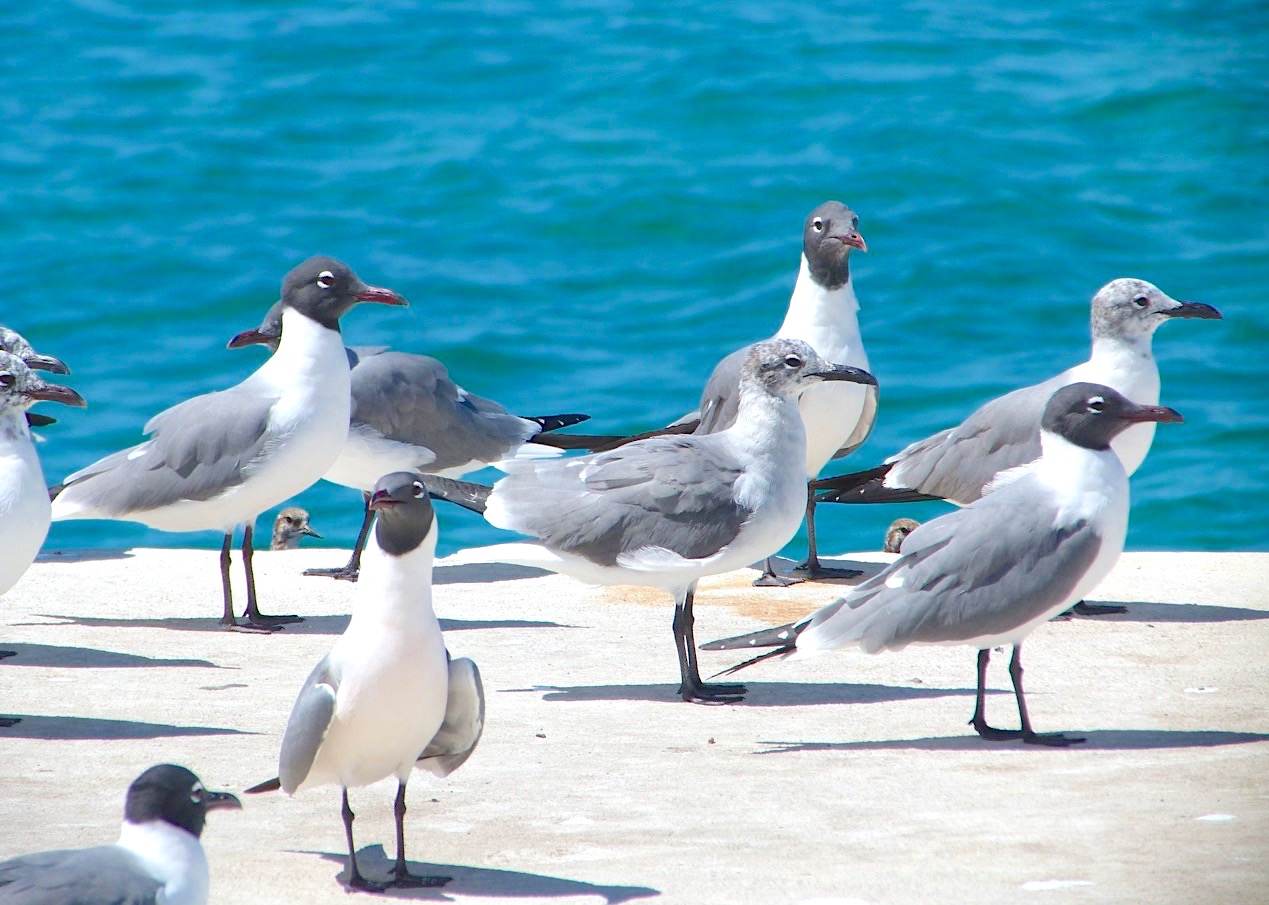

The Bahamas Marine Mammal Research Organisation (BMMRO) is based at Sandy Point, Abaco. The principals Diane Claridge and Charlotte Dunn with their team cover not only Abaco waters but the whole of the Bahamas. Their research work is complex, and some of it is carried out in conjunction with partners on specific projects or more generally.
Which brings me to SailorDolphin Research, a project that involves the meticulous mapping, photographing, and recording of the details of each sighting. Much of the work is carried out in the Bahamas in partnership with BMMRO. The link will take you to the homepage, which notes “This website provides a list of Dolphins that I have documented on the US East coast and the Bahamas. It includes details (with photos & notes) for each dolphin and lists of their sightings from my personal database.” If you have an interest in dolphins (and who does not?), it will repay exploration – and you will see some awesome photographs. Here are a few of them to admire.
Now imagine yourself in the water, with these wonderful creatures cutting through the water in front of you, working their sleek bodies just below the surface, jostling and cavorting, occasionally letting a fin cut through the water. Hold that thought… Right, get back to work!
All photos courtesy of SailorDolphin / BMMRO

There’s a strange affinity between humans and whales. Humans seem to think so, anyway – and whales seem to tolerate them amiably, perhaps now that the decimation of their populations by humans is (largely) a thing of the past. The Bahamas in general and Abaco in particular are in the mainstream of progressive cetacean research, led by the BMMRO at Sandy Point.
One of the speciality research species is the Blainville’s Beaked Whale. These magnificent creatures are deep divers, and although they are found in many parts of the world, the Bahamas is one of only 3 locations with a significant population for study. Most of the whales here were photographed within sight of land (and a few with the Castaway Island Disney Cruise Ship visible on the horizon!).
I’ve been lucky enough to be on the BMMRO research vessel on a beaked whale outing – and luckier still that we were able to spend plenty of time with a group of them, including some males. The header image is of a mature male with his huge teeth that protrude upwards from the lower jaw, and in time become encrusted with barnacles.
The whales were quite undisturbed by our presence – indeed they behaved much like dolphins, circling the boat and swimming under it; moving away and returning. This was an opportunity to count the whales, to identify those that had already been recorded, and to document any new ones. Each whale has its own unique pattern of marks, striations and in some cases healed wounds. The pair below are a good example.
Also, the whales have individually distinctive dorsal fins, with nicks and tears that also act as a means of identification. These can often be made out from a distance with powerful binoculars or photographed with a long lens for later analysis (this ID method also works reliably for dolphins).
Beaked whales often bear the healed scars from the gouging bites of COOKIE-CUTTER SHARKS, a vicious little species that I recently featured. The distinctive circular scars on the back of the whale below result from encounters with these unpleasant creatures.
Finally, the photo below. It has no merit, photographically speaking, but I love the way that sometimes a ‘risk’ shot – into the sun, perhaps – produces rather magical effects. The unexpected ‘sea stars’ were a bonus!
All photos: Keith Salvesen / BMMRO

‘Disporting’. Not a word I’ve used very often. Or possibly ever. It looks a bit like ‘unsporting’, which is emphatically what dolphins are not. Basically, it just describes what dolphins are doing when you see them on the surface: amusing themselves, frolicking around in the waves, and simply enjoying themselves.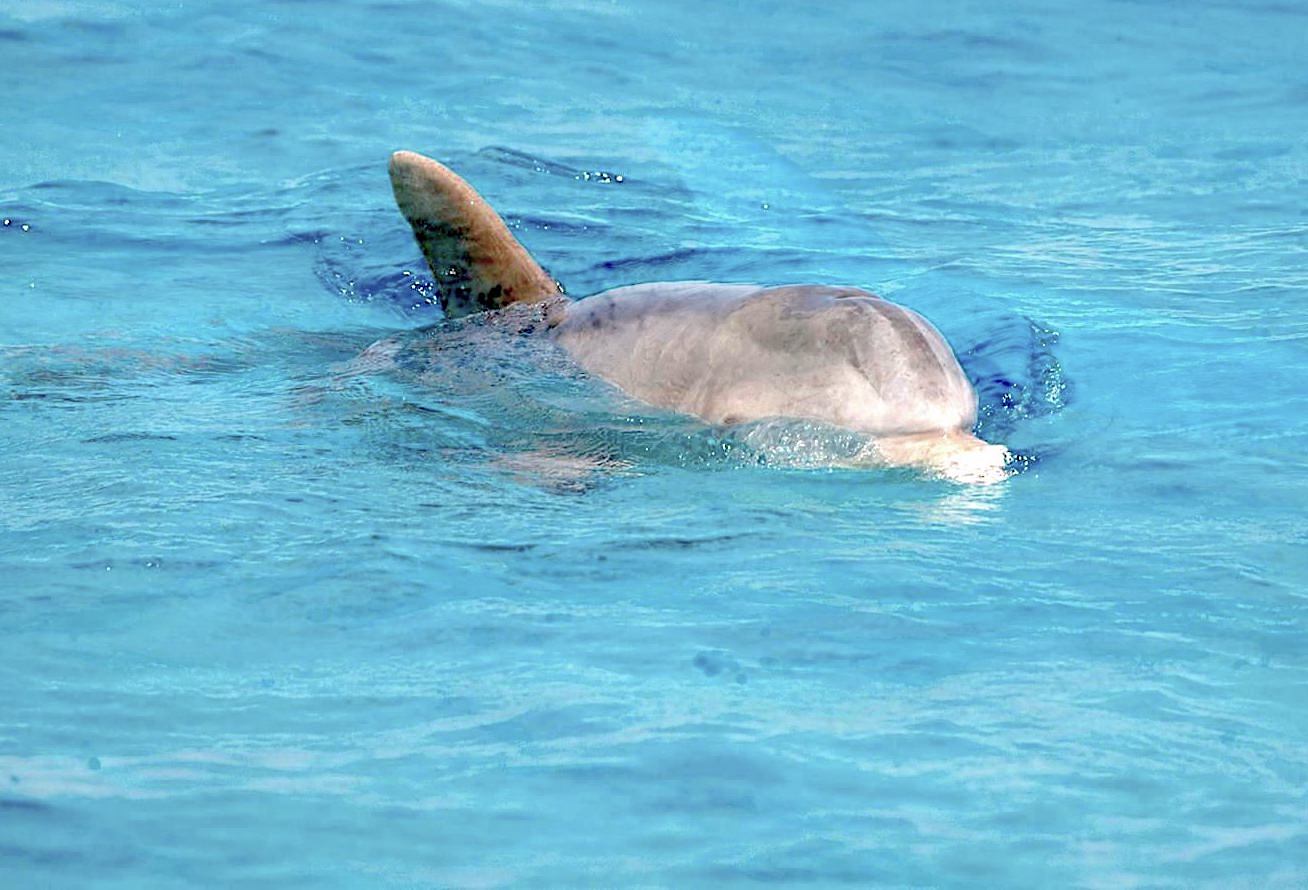
True, they are probably keeping an eye out for food… But when you have a group sociably following alongside the boat your are in, moving in front, dropping behind, diving under, and generally playing around, it’s quite hard to believe that these are completely wild creatures. They seem to be performing just for you, simply because they want to. You don’t even have to throw fish at them to earn this free display.
As is well-known, the BAHAMAS MARINE MAMMAL RESEARCH ORGANISATION (BMMRO) is the custodian for the welfare of these beautiful creatures for the entire Bahamas. However, being based on Abaco and carrying out the majority of the research from the HQ at Sandy Point means that many of the great images that get taken are from Abaco waters. Indeed some are taken within swimming distance (not mine) of the shore. 

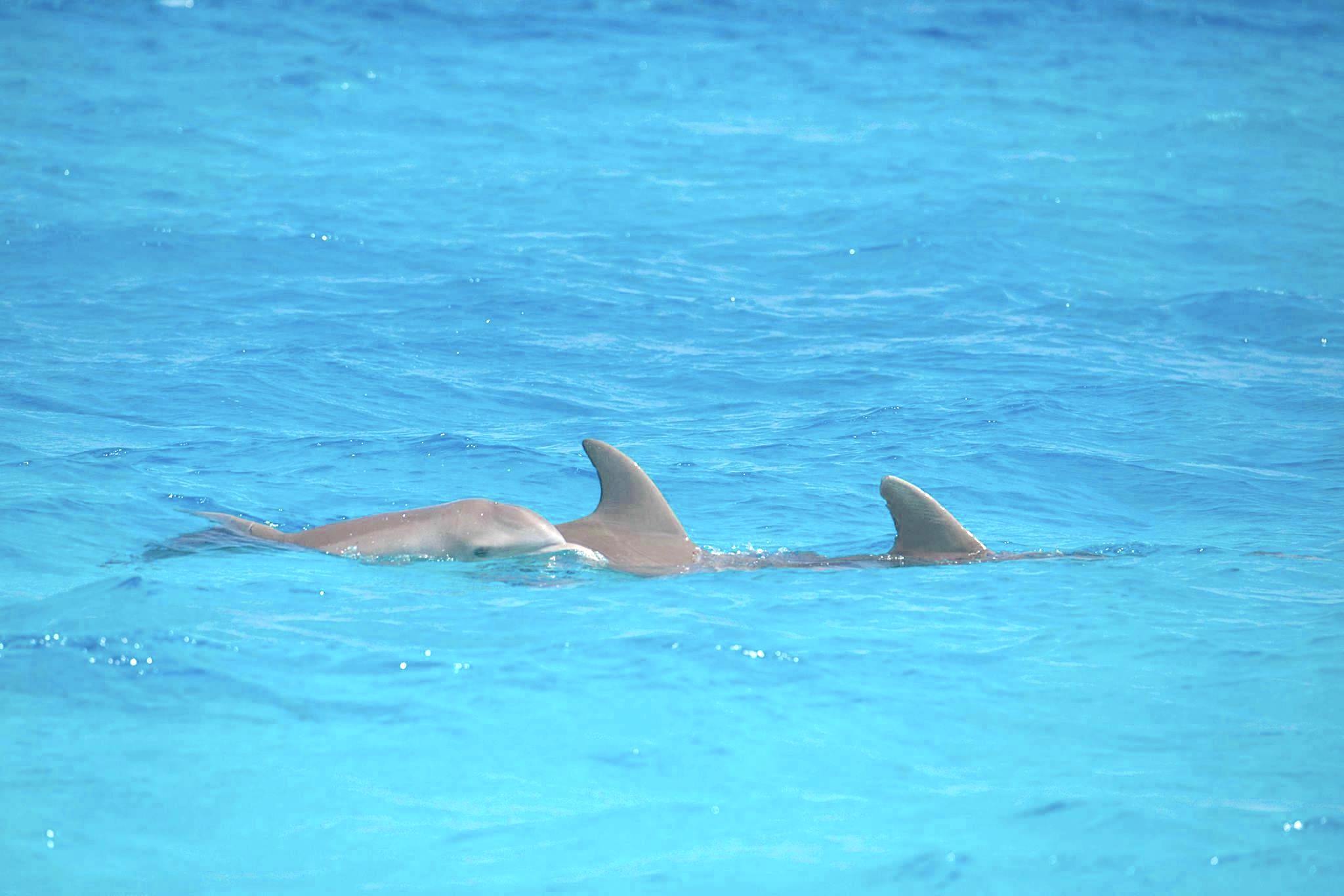

The photographs featured here were taken during the last few weeks. Some are of the familiar bottlenose dolphins. The others – with speckled undersides clearly visible in the header image & below – are of Atlantic spotted dolphins. There’s even one of my own taken from the research vessel. 

For the researchers, the most important part of an individual dolphin is its dorsal fin. Unique patterns of cuts and scars mean that each dolphin sighted can be logged and their profiles built up. Some have been found in the same area for many years. They are not usually given jocular names – ‘Davy Jones’, ‘Finny Phil’ or whatever. The first time we went out on the research vessel we were slightly surprised by the practical, scientific calls during a sighting of a dolphin group: “there’s B4 again” and “over there – D5 is back”. All said fondly however – many of the dolphins are old friends.
This dolphin has a notable notch on the dorsal fin with a nick below, & a scar line – with a prominent white scar on the lower front edge 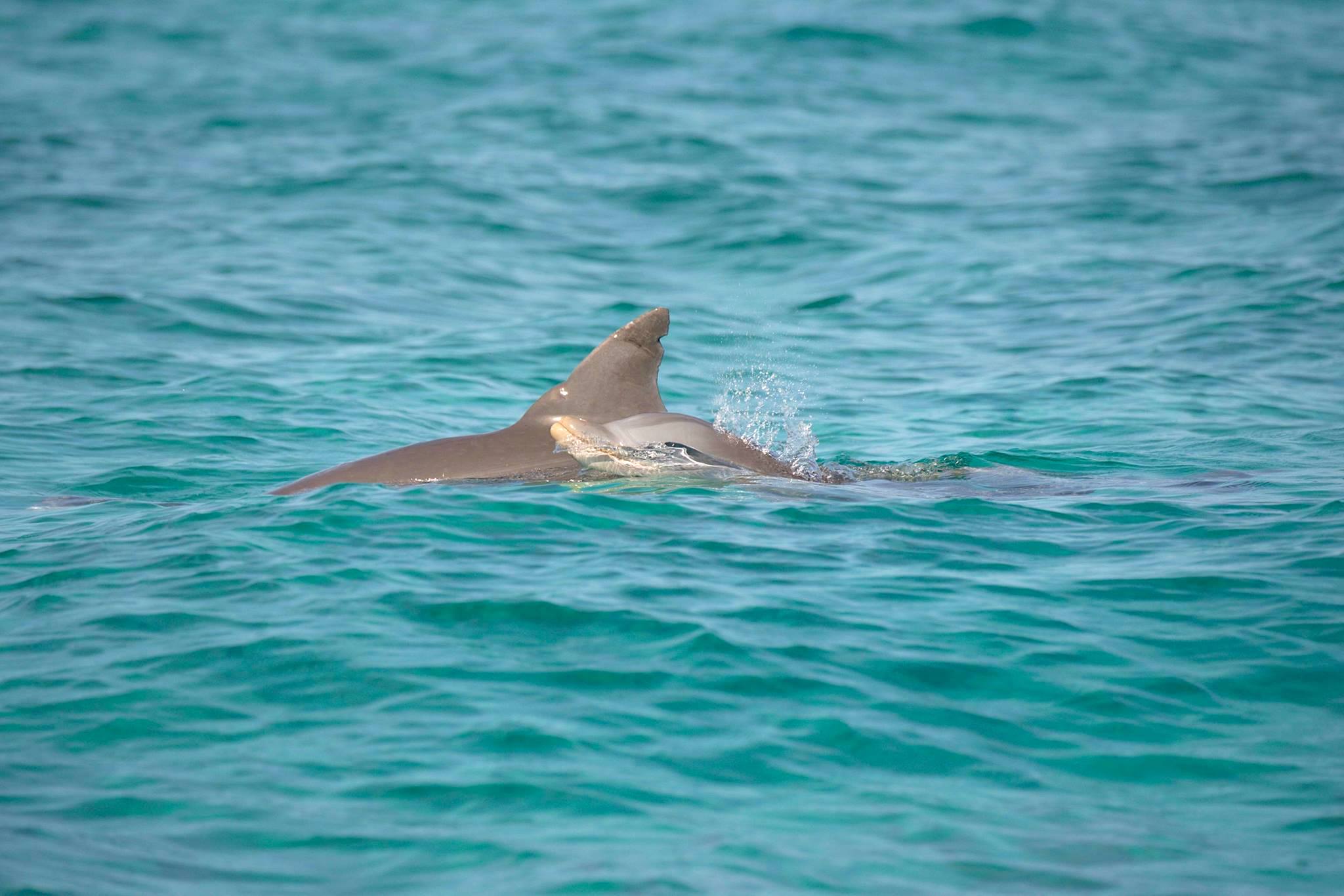
Notice how these 3 dolphins all have quite different fin profiles. The nearest one’s fin looks unblemished, but has a paler tip. Powerful binoculars and a serious camera can pick out small differences at a distance that the eye could not
Coming soon: Manatees & Man in the Bahamas
All photos (bar one by me) BMMRO, with thanks to Diane & Charlotte, and a tip of the hat to the current interns involved in the research projects (Hi, UK Thomas!)
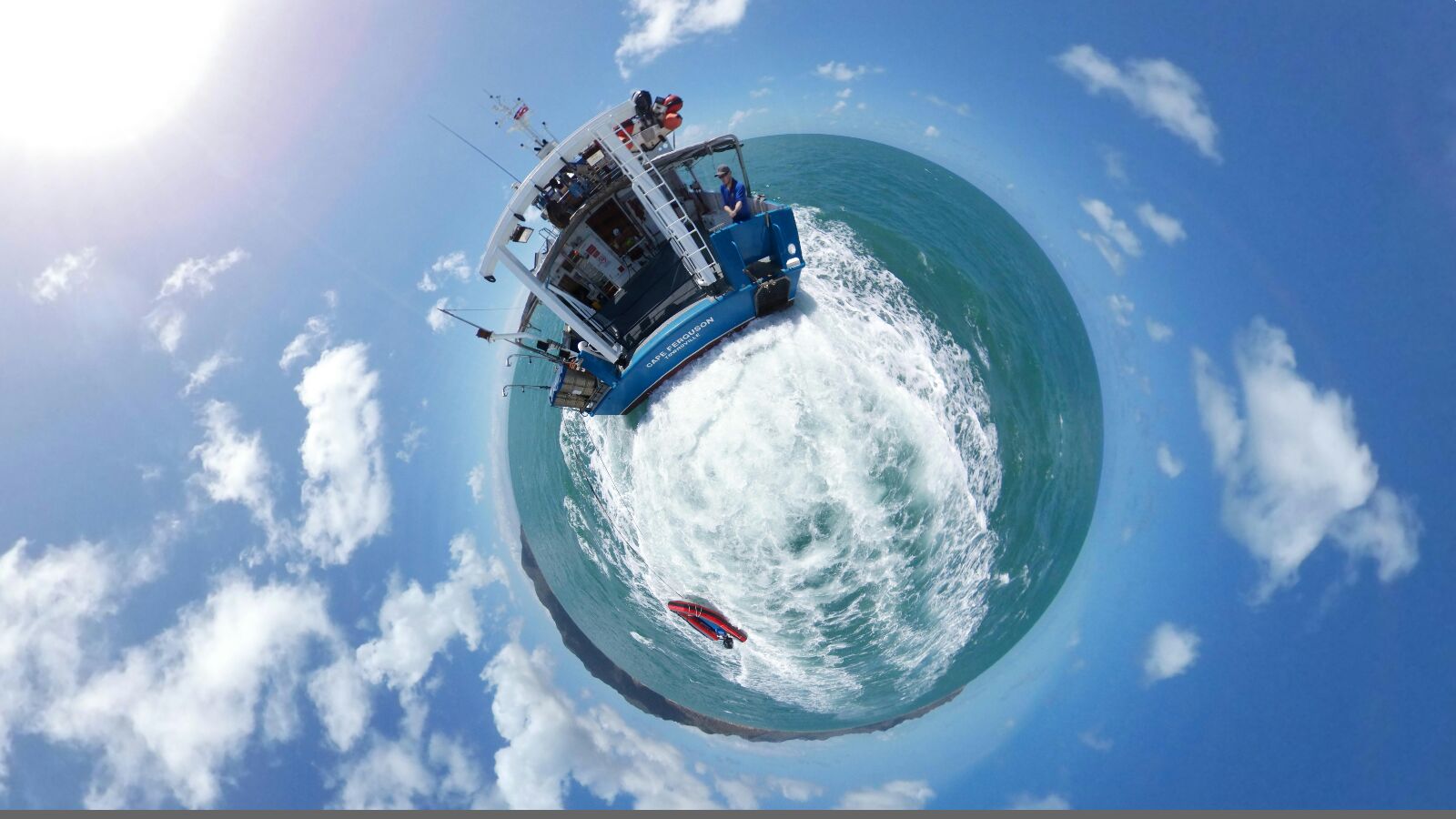
Four years ago a young English friend of ours, Oscar Ward, was lucky enough to be offered an internship with the Bahamas Marine Mammal Research Organisation (BMMRO). At the time, he was post-school, and waiting to start a degree course in marine biology at university. He had no practical experience at all, so he had to progress from the menial tasks (scraping barnacles off the bottom of the research boat) to the more adventurous (whale poop-scooping) to the scholarly (collection and analysis of samples and data, including audio file matching of whale calls for identification). The need for hard work, concentration and accuracy were made clear from the outset… and as you will see, Oscar’s short internship has stood him in very good stead during his university course.
Oscar weekending at Gilpin Point – self-sufficient
From a promising start on Abaco, and with 2 year’s study behind him, Oscar is currently spending the 3rd year of his 4-year course in Australia, working with The Australian Institute of Marine Science. He has been involved in a number of complex projects focussed on corals and reef life – as we all know, a matter of huge concern – and the projections for the future of the reef systems in a time of warming seas and raised acid levels. Oscar also assists PhD students, for example examining the damaging effects of parasitic worms on coral; and the effect of changing light conditions on corals.
Much of Oscar’s time has been spent doing fieldwork. Often he is at sea, monitoring and collecting samples in the Southern Great Barrier Reef, diving two or three times a day. This work is often carried out in restricted or preservation zones, and with ever-present manta rays, sharks and sea turtles around him.
Right now Oscar is involved with the investigations into the recent bleaching events, work that is at the forefront of serious concern for the GBR and far beyond. I have recently corresponded with him – he has definitely not forgotten that his grounding for the fieldwork and studies that he is engaged in – and very likely his career – came from his time on Abaco and the lessons he learned during his time with the BMMRO at Sandy Point. (In part 2: another good intern, currently at Sandy Point)
All photos: Oscar Ward (the header image is taken from a research vessel – no idea how, maybe a drone with fish-eye lens?)

The Bahama Mockingbird Mimus gundlachii is similar to its slightly smaller cousin, the widespread Northern Mockingbird Mimus polyglottis. The range of Bahama Mockingbirds is not restricted to the Bahamas themselves, and includes areas of Cuba, Jamaica and TCI, so despite the name they are not an endemic species to the Bahamas. They are also occasional vagrants to the United States, especially – for reasons of proximity – southeastern Florida.
The Bahama Mockingbird is browner than the greyish Northern Mockingbird, and has distinctive streaking and spotting to its breast and undercarriage. This may extend to what you might describe as the bird’s ‘trouser legs’, though I’m sure there’s a more technically correct term.
Both mockingbird species are found on Abaco. The NMs are ubiquitous in towns, settlements, gardens, coppice and pine forest, whereas BMs are shyer and tend to be found in the pine forest and well away from humans and their operations. When we were putting together The Birds of Abaco, I went on a birding trip with Abaco birding legend Woody Bracey and Ohio bird photographer Tom Sheley. We took a truck into the pine forest down a logging track south of Delphi, and they were quick to locate a bird, not least because one was sitting prettily on a branch singing lustily and unmistakably. It was well within range of Tom’s massive lens; more of a struggle for my modest camera (below). Caught the cobwebs, though…
I was astounded by the beauty and variety of the song. It consisted of very varied notes and phrases, each repeated 3 or 4 times before moving on to the next sounds in the repertoire. Here is a short 18 second example I recorded, using my unpatented iPhone method, for which see HERE.
For those with interest in birdsong, here is a longer 1:13 minute song from the same bird, with largely different sounds from the first recording made minutes earlier. There’s even a decent stab at imitation of a 1960s Trimphone™. Had we not had to move on to Sandy Point for an appointment with some cattle egrets and American kestrels, I could have stayed listening for far longer.
THE ‘SUBSPECIES’ THAT WASN’T…
More recently, on a trip in backcountry to find Kirtland’s warblers – we saw 4 – the slow-moving truck jolted to halt in the middle of nowhere. This was because a Bahama Mockingbird was right by the track. I fired off some quick shots out of the window into a rather difficult light, to find that we appeared to have found a new subspecies, the scarlet-faced mockingbird.
The reason was clear, however. The bird had been pigging out on some red berries, and had managed to collect plenty of the juice round the base of its beak. 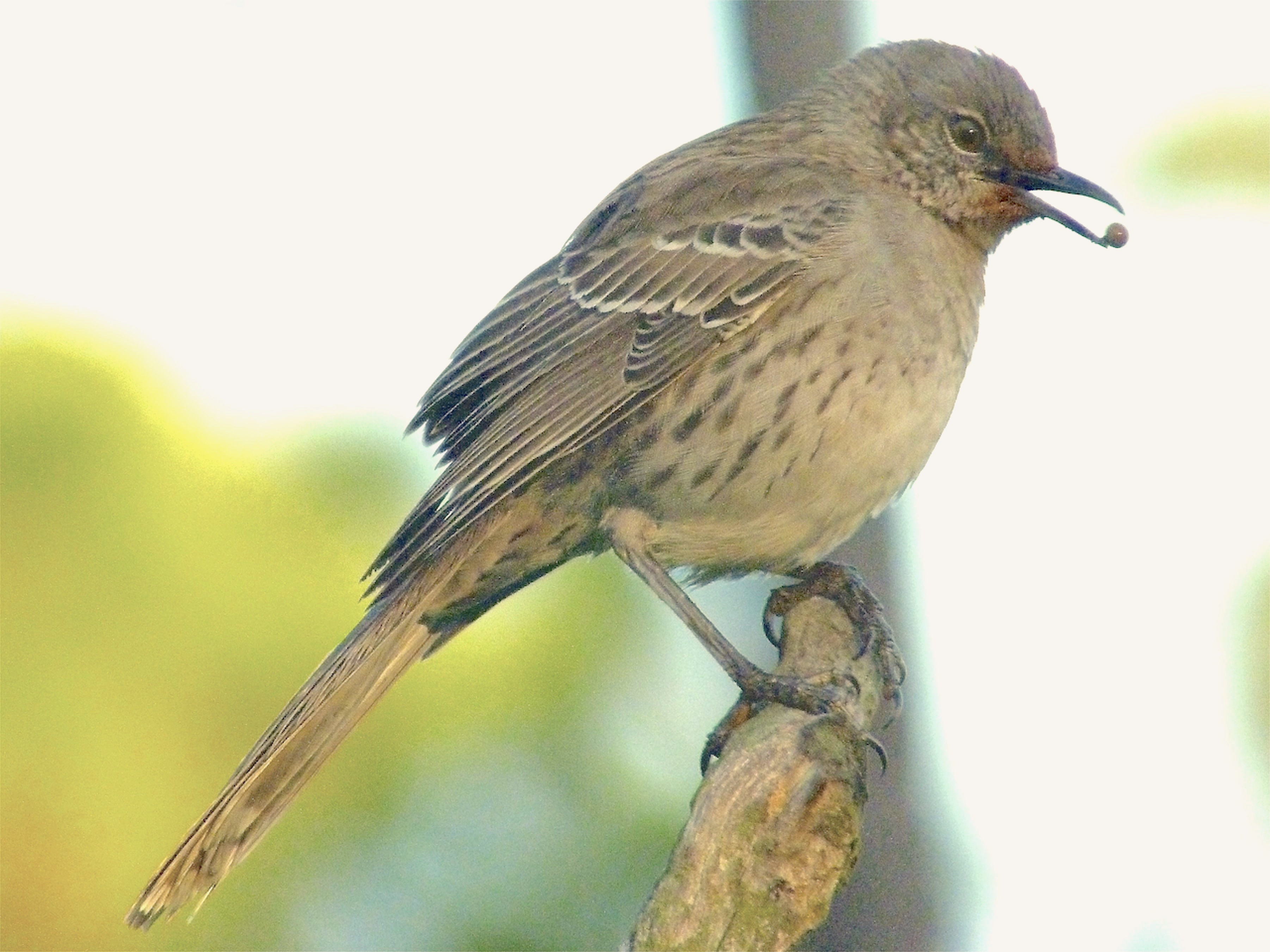
SO WHAT DOES A NORTHERN MOCKINGBIRD LOOK LIKE, THEN?
I photographed the Northern Mockingbird below in a garden at Casuarina. The species is far tamer than its cousin, and seen side-by-side they are clearly very different. The range maps show the stark contrast between the very limited range of the Bahama Mockingbird and the vast distribution of the Northern Mockingbird.

Photos Credits: Tom Sheley (1, 6); Peter Mantle (2); Charlie Skinner (3); Keith Salvesen (4, 7, 8, 9); Alex Hughes (5); Susan Daughtrey (10). Range maps eBird & wiki.

Six more sleeps. That’s all. Suddenly, a trip that seemed ages away is rushing towards us. Or, to put it more plausibly science-wise, we are rushing towards it. Abaco beckons, with bonefish, rays, sharks, reef fishes, whales, dolphins, birds and butterflies to investigate. Plus Kaliks to consume.
Idly thinking along those lines and vaguely plotting the first few days, took me to Sandy Point, home of the BMMRO (Bahamas Marine Mammal Research Organisation) and of course the legendary Nancy’s, the restaurant at the end of the road. From where it is a short step to the dock on which the pelicans gather and use as a launch pad for their fishing dives.
I photographed this bird at the end of the SP dock, looking rather bedraggled after a dive
Note the significant plumage differences between the male (above) & this female
I recently read somewhere that the brown pelican is (or has become) quite uncommon in the Bahamas. On Abaco it is a permanent resident breeding species, so a drop in numbers equals fewer nests, fewer chicks and… fewer numbers. It’s a classic cycle towards serious population decline and all that is implied. Has anyone noticed an apparent reduction in numbers, I wonder? Comments welcome.
The pelicans above were all photographed on Abaco. The two below were not, but are both by exceptional photographers. One, Phil Lanoue, specialises in dramatic sequences, and his work features elsewhere in this blog. The final image was sportingly uploaded by Alan Schmierer from Flickr into the ‘public domain’.
While we are on Abaco, I plan to keep posting as and when, subject to connectivity (always a proviso in the Bahamas). My big hope is that the piping plovers that were on the beach last year and returned this season, will have resisted the increasingly insistent call to fly north to the breeding grounds. If they could just hang on for just a few more days…
Credits: Tom Sheley (1); Tony Hepburn (2); Keith Salvesen (3, 4, 6); Woody Bracey (5); Phil Lanoue (7); Alan Schmierer (8); Birdorable (cartoon)
Sandy Point is the absolute end. Literally. Abaco’s only highway runs 120 miles from north to south. Towards the end, it hooks around to the west, then back north a short distance to the small community. You can drive on right through the settlement, with its criss-crossing side streets. Best stop driving when you see the ocean: you’ve run out of road.
Sandy Point is home to the renowned Nancy’s culinary establishment, maybe a half-hour drive from the previous place you could get a meal along the highway. It’s that remote. The menu is elementary, the Kaliks are cold, the view from the verandah is out to the wide sea and the pelicans smashing down into the water off the sand bars. And sooner or later you will find a dog’s head in your lap. This is not part of an unordered Abaconian special menu with a Godfather theme; it’s a potcake looking for chicken. Or fish. Or chips. Or anything edible really.
The origins of these ‘community dogs’ – no one’s and everyone’s – are many and various, just like their assorted shapes, sizes and colours. You can read about their history, the reason for their name, and about ‘Amigo’, the most famous potcake of all, HERE. There are many of these semi-feral dogs on the island, slinking around the settlements and even the main town. They have a tough life. They are generally ignored or shooed away. But in Sandy Point at least, they seem healthy and well-fed. Nancy’s may have something to do with it…
The potcakes of Sandy Point make the beach and the sea their playground. If you walk along the strand and round the point, they may tag along for a while. Then they get bored and rush off. When the tide is low, they will trot along the exposed sandbars right out into the sea. Or chase each other into the sea. Or maybe just relax and watch an endemic Bahama swallow flit past.
There are active potcake rescue schemes aimed at rehoming strays. Spay and neuter clinics are regularly held. The aim seems to be to keep the numbers down with benign control rather than anything more radical. And rehomed animals make excellent pets, being “intelligent, loyal, calm, and resilient”. I’m guessing the potcakes of Sandy Point reckon they have a pretty good life as it is.
AND FINALLY… here is a video with a difference: Salty Dog the potcake goes mad on a beach – wearing a GoPro! Great idea…
Credits: All photos by the management

To be honest, I haven’t done these fine birds justice. Barely a mention of them for 3 years. Too much else on the land and in the water to choose from. I posted some of my photos from an outing to Sandy Point HERE. And the kestrel kinsman MERLIN got some attention a while later. Time to make amends with some more AMKE.
As many or most of the images show, utility wires (also posts) are a favourite perch for kestrels. They get an unimpeded view of the only thing that really matters in their lives – outside the breeding season, of course – PREY.
In my experience it’s quite rare to see AMKEs on the ground – unless they are in the act of ripping up some hapless rodent pinned to the earth. I was with photographer Tom Sheley when he captured this fine bird in the grass.
Tom also took this outstanding photo, on an overcast day, of a kestrel feeding its fledgeling a large insect.
Treasure Cay and its surrounding area makes for a good day’s birding. Although South Abaco, below Marsh Harbour, is the go-to location, TC has plenty of scope for a great variety of species from shore birds to songbirds – including the occasional Kirtland’s warbler. The golf course pond at hole #11 is well worth checking out (with permission at the club house, rarely declined unless there’s an event of some sort). So is the large brackish lake system where you may well find herons and egrets. There’s been a rare (for Abaco) pearly-eyed thrasher there recently. And you may find yourself being watched by a kestrel from a vantage point.
A kestrel in streamlined flight, with its feet tucked tightly under its body
OPTIONAL MUSICAL DIGRESSION
One of Leonard Cohen’s standards, and a song covered by almost everyone from Johnny Cash to Heathen Gonads*, Bird on the Wire was on the album Songs from a Room (1969). It was a favourite of Cohen’s, who once said “I always begin my concert with this song”. Covers range from the excellent via good, interesting, and strange to outright bizarre. Joe Bonamassa’s take on it (as Bird on a Wire) on Black Rock, is certainly… unusual**.
Credits: Bruce Hallett (1, 10); Charles Skinner (2); Peter Mantle (3, 9); Tom Sheley 4, 5, 6); Nina Henry (7); Tom Reed (8)
*not really . **shows originality & ingenuity -vs- dents his purist bluesman credentials

Dolphins are regularly seen around the coast and in the fishing grounds of Abaco. Sometimes, they make it easy by nosing into harbours and being generally adorable for a while, to the delight of onlookers. Hope Town can be a good place for this. Those aboard the “Donnies” – the ferries that criss-cross the Sea of Abaco from the main island to the various Cays – may be in luck too. However, it is perhaps less well known that Abaco waters provide a home or a migratory passage for gigantic whales. Beside these mighty creatures, the several other whale species of the Bahamas seem relatively small. Yes it’s true: there are huge whales – humpbacks and sperm whales (cachalots) – to be found in Abaco waters, and not so very far from land either.
The humpback whale Megaptera novaeangliae above, with its characteristic white pectoral fins, was seen about a week ago off Sandy Point (southwest Abaco). You’ll get an idea of its immense size from the photo. An adult of this BALEEN WHALE species can reach 50 feet in length and weigh 35 tons or more. Imagine watching one slipping silently past your boat… and then consider that even larger sperm whales are seen in the same area.
For the link to report a Bahamas whale sighting, please see either link provided below
Humpback whale / adult male human in scuba gear comparison

Humpbacks are found in oceans throughout the world. They migrate huge distances each year, from polar regions to the tropical and sub-tropical waters where they breed. These are the whales beloved of wildlife film producers and whale-watching trips, with their spectacular arched breaching in which half their length or more may emerge from the water before smashing back into the waves.
A humpback breaches on the Stellwagen Bank (about 50 miles offshore of Boston)

Like other large whale species, humpbacks were unsurprisingly prime targets for the whaling industry in a melancholy era of marine history that took them to the edge of extinction until a moratorium was declared in 1966. Since then the population has recovered significantly. They remain vulnerable, however: in some locations, to killing; to entanglement in heavy-duty fishing gear; to ship collisions; and to noise pollution that affects their ability to communicate long-distances underwater, as they need to do.
Finally, the Sandy Point humpback makes a last dive and, with a wave of its fluke, disappears 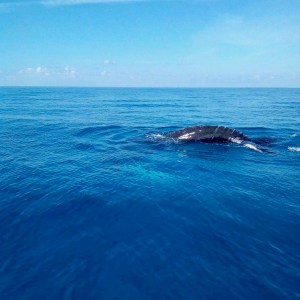

Do you have a Bahamas whale or dolphin sighting to report? Please use this link, giving as many of the details as you can. Each report makes a valuable contribution to the BMMRO’s research.
http://www.bahamaswhales.org/sightings.aspx
As a footnote, my first whale encounter was on the Stellwagen Bank mentioned above, when I went on a whale-watching trip from Boston. We encountered a mother humpback with her calf and spent about 1/2 hour watching them interacting. I have the memories luckily – my photos were rubbish, using a very early digital camera that these days would be less effective and well-spec’d that a luminous pink plastic child’s camera now…
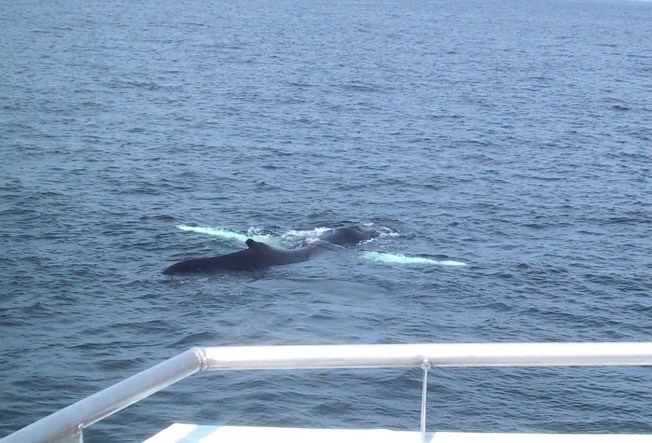


RELATED POSTS
Credits: Brad & his crew, and the BMMRO; Whit Wells / Wiki for the breaching whale; moi for the rotten but quite interesting archive photos from the same place; the whale for being awesome in the true sense of the word

The conch. Such a fascinating gastropod, and with so many uses both culinary and decorative. In certain cultures, religiously significant. A rudimentary musical instrument for a shell. And did I mention delicious?
Live conchs enjoy motoring around uninhibitedly on the sea floor, keeping an eye out…
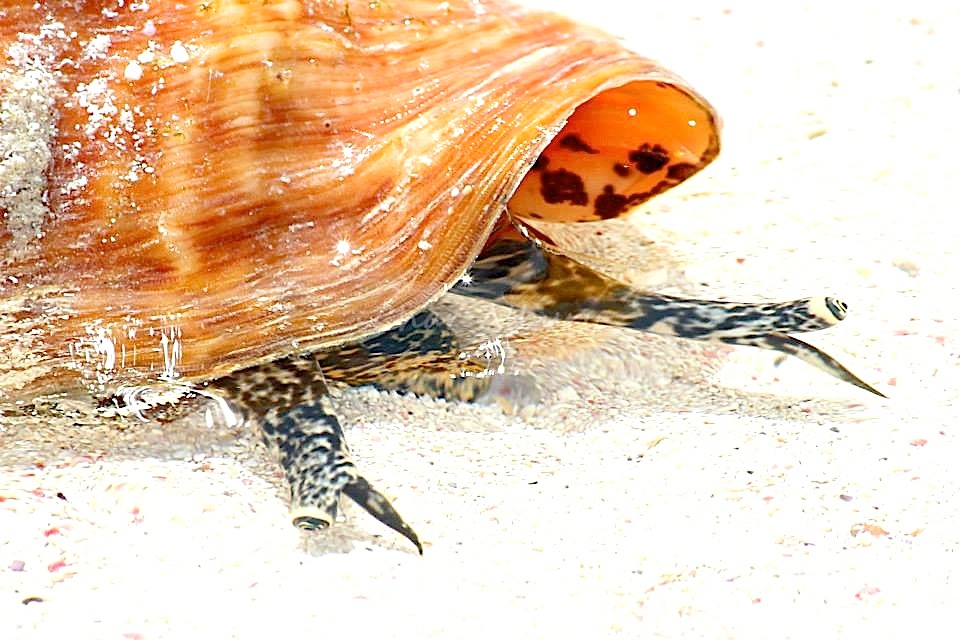

Conchs also enjoy racing each other…
“Eat my dust…”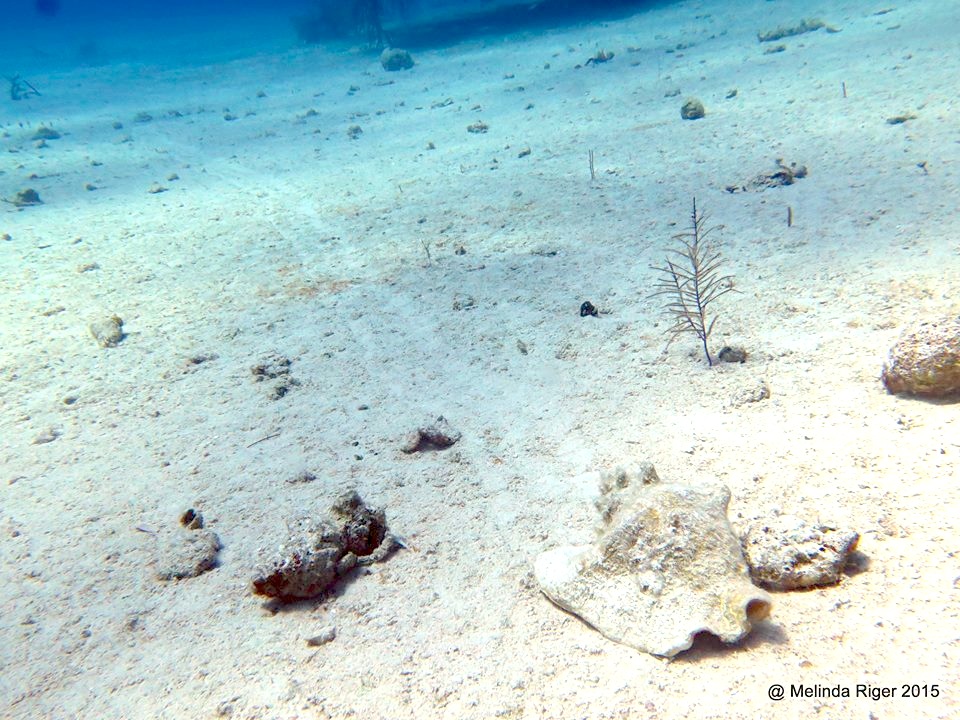
Conch Pearl – one of the rarest natural pearls in the world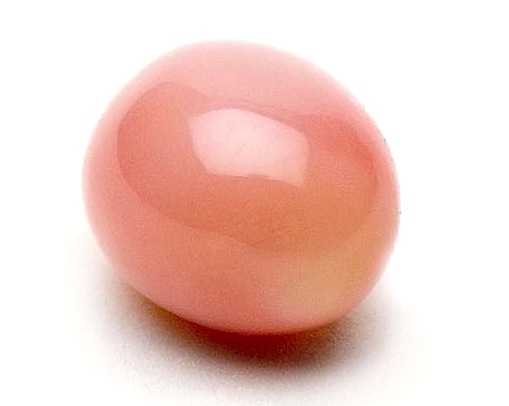
A conch spiral close-up

Conch shells just lie around the place at Sandy Point

Conchs are widely used for serving cocktails or as ashtrays in the best beach bars*
*This is a lie. Sorry about that. I meant to say “make prefect table decorations”
Image credits: Keith Salvesen / RH (1, 9, 10 ,11); Melinda Riger / GB Scuba (2, 4, 5, 6); Charmaine Albury (3); AmbergrisCaye.com (7); Rhonda Pearce (8)

Sandy Point always promises well for birding. There are plenty of ‘good’ birds to see there, depending on the time of year: tropicbirds, frigatebirds, ospreys, brown pelicans, white ibis, cattle egrets, other egrets and herons, kestrels, and a variety of shorebirds. And gulls. We encountered a pair of Laughing Gulls perched on a piling.
To begin with they were laughing merrily. Then they quietened down. Maybe one of them told a somewhat off-colour joke. In the sequence of photos below, you can see the left hand gull tensing and preparing to fly. Then it does – leaving his buddy all alone to contemplate the consequences of causing a sense of humour failure…



This is the sound of a pair of laughing gulls on the Marls objecting as we slowly poled through the mangroves towards them. Not laughing, but complaining…
Photos and movie clip: RH

The small settlement of Sandy Point is literally at the end of the road. Beyond the limit of the tarmac lies the shallow sea. The Highway – Abaco’s only main road – extends the length of the skinny island, 120 miles roughly north to south with occasional side roads to settlements, dirt roads, forestry tracks, and something a bit more significant for Marsh Harbour – a roundabout, a single set of working traffic lights, the only ones on the island. There’s a second set but I have never seen them working. I don’t think anyone ever has. Maybe they were never even wired up.
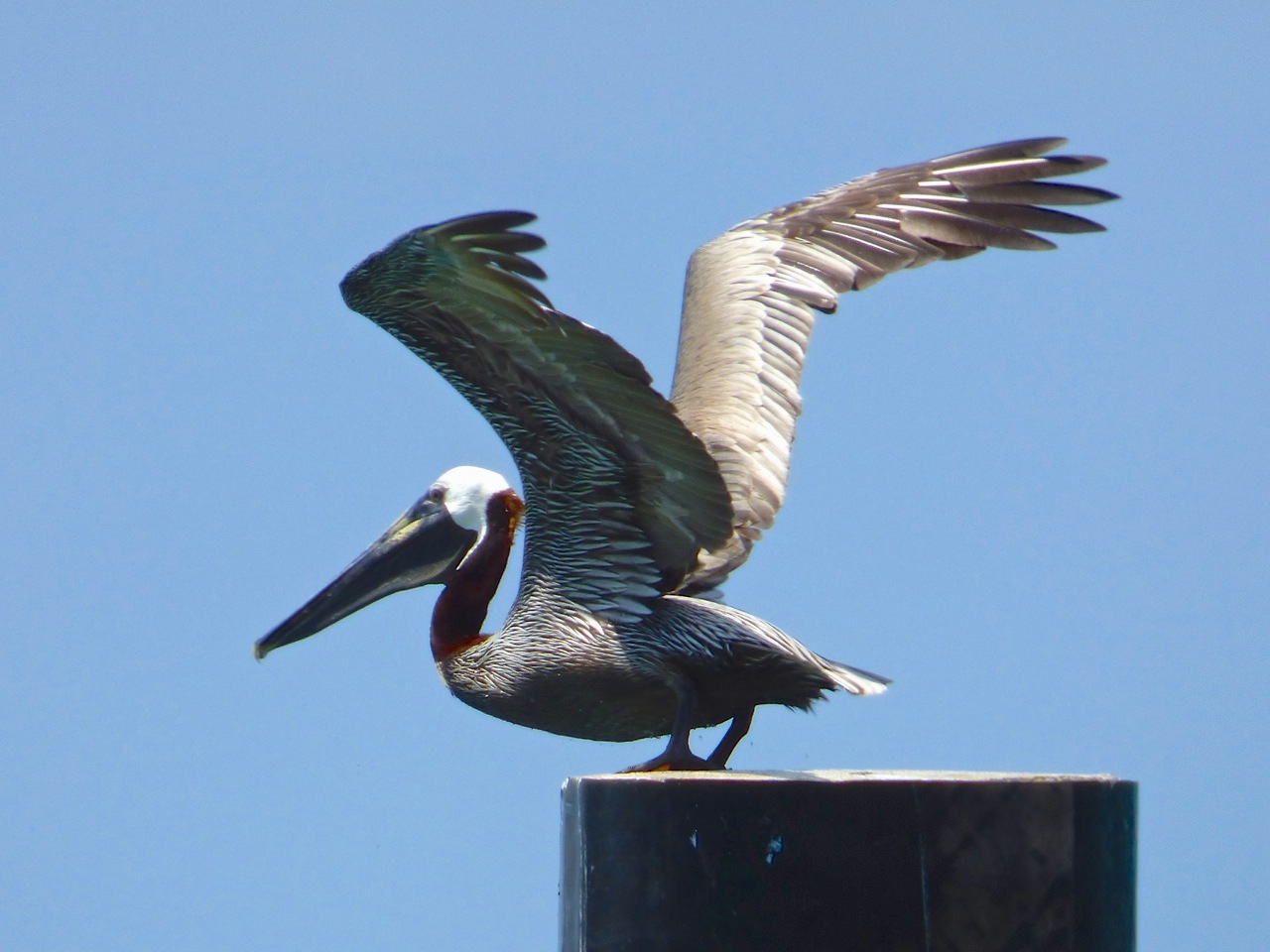
We went to Sandy Point for lunch with friends at the famous (though not yet world-famous) Nancy’s, with its reliably comforting menu of a choice of the same 3 dishes permanently on offer (fresh fish, conch, or chicken), plus Kalik or Sands beer. Simple yet satisfying. Sandy Point is a great place for birding, both sea / shore / wading birds, and land birds. Ospreys are often around. And brown pelicans. At high tide they dive off the dock (see HERE). At low tide, when the long sand bars are just visible above the water level, the pelicans use them as base for their fishing operations, often some 200 yards from the shoreline.
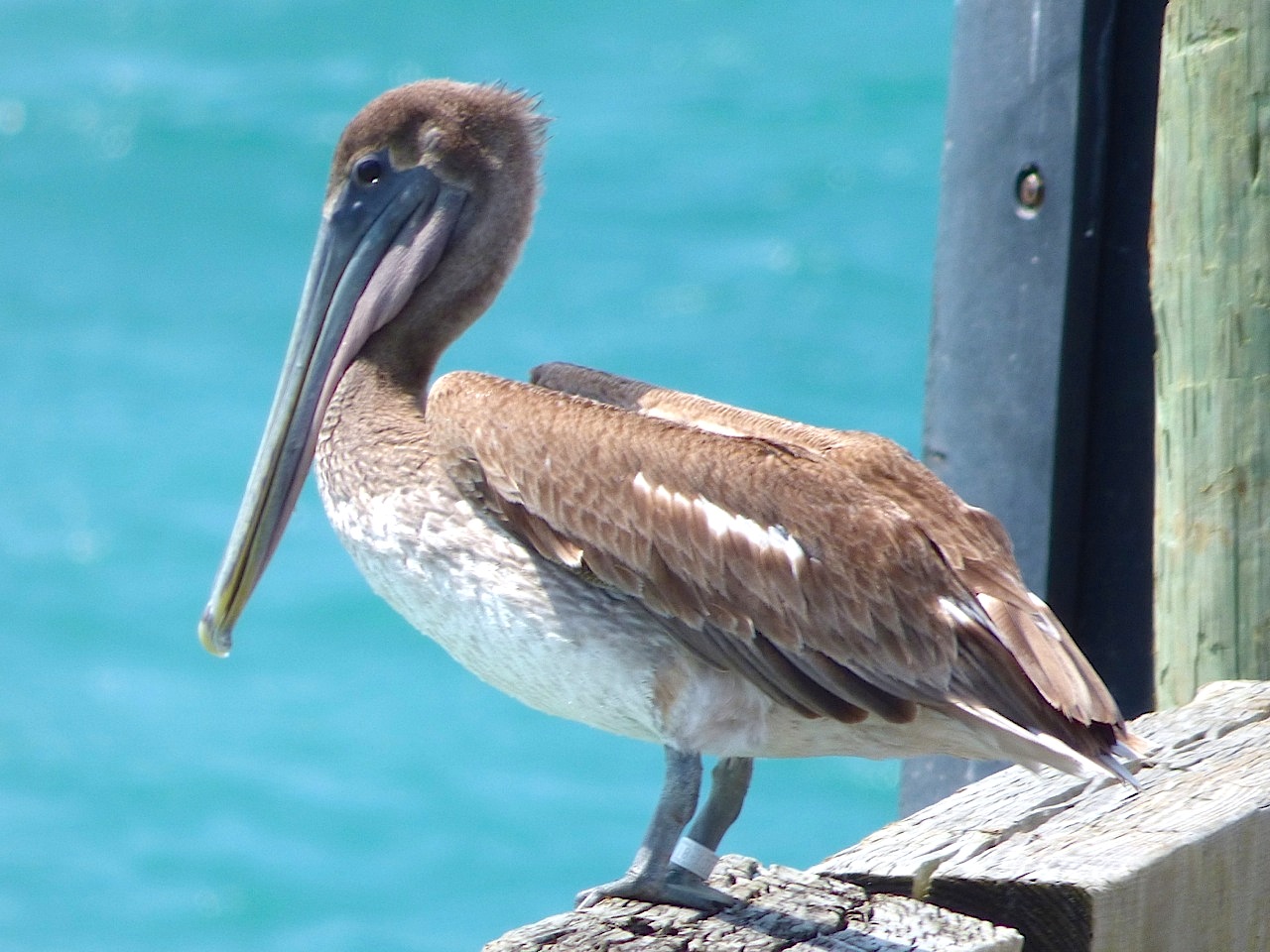
We were watching 5 pelicans doing just that – lazily flapping aloft from the water in their clumsy way, then turning swiftly and diving with some elegance before smashing into the water for fish, returning in triumph or sorrow to the sand bar to eat… or plan the next foray. Then one detached itself from the group and flew closer to us for a single dive in deeper water, before flapping heavily back to the sand bar.
I took a sequence of photos with ‘Hated Camera’ (having drowned ‘Loved Camera’ in a minor marine mishap). As I have since discovered, ‘HC’ was on the wrong setting the whole time – by which I mean several days (some small but important side switch I’d neglected to remember). Hence the pelican images are in small format because I am slightly ashamed of the quality… There’s a theory about cartoons that there are two possible reasons for pairing them together on a magazine page: (1) they are each doubly funny and therefore only need half the space; or (2) they are only half as funny and so two are needed to double the overall chuckle quotient…
So here is the pelican dive sequence – unsuccessful in terms of fish – with the bird then flying back past us to the sand bar to rejoin his 4 buddies. I’ve put 2 images per line – either because (on the cartoon principle above) they are so good they only need half the allotted space or (hint: this is the truth) they are of such indifferent image quality that I am too embarrassed to enlarge them…
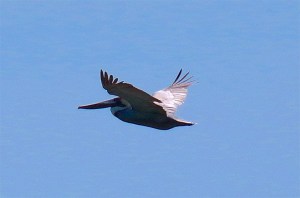



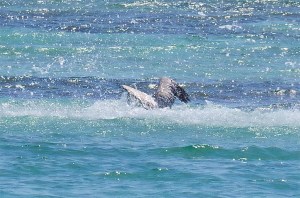







In the final image you can just make out a spooky ghost ship on the horizon. This is the huge vessel moored at the ‘Disney’ island, historically named Gorda Cay but now ‘pirated up’ to Castaway Cay. Arrrrrrrr!
Credits: all images RH & ‘Hated Camera’; Mrs RH kindly being encouraging about the results

Gina (adult female) and her calf – last seen August 6th, 2015 in Spanish Wells Key feature – numerous paddle cuts; white oval scar on left side of back; linear scar on posterior right side of body
Four years ago, there were no manatees in Abaco waters. Then a couple of adventuresome sirenians made the trip over from the Berry Is. and since then, there have been at least one, sometimes two and occasionally three resident on Abaco. And for slow, gentle, animals they certainly move around, too. In the past, I wrote quite often about the manatees, charting their journeys based on satellite tracking and sightings. I reported the tantalising prospect of the young male, Randy, hooking up with young female Georgie in Cherokee Sound, only to turn back when he reached Little Harbour. You can read more about the manatees of Abaco on my manatee page HERE.
Georgie’s epic trip (Sept 12) continued to Cherokee Sound; and Randy’s ‘pursuit’ (Sept 14)

The most comprehensive source for Bahamas Manatee information is now to be found by joining the open Facebook group BAHAMA MANATEE CLUB, skilfully curated by Felice Leanne Knowles. There, you can follow the meanderings of your favourite Abaco manatee, watching as he or she moves around the island and cays. In recent months there have been sightings of single or pairs of manatees in several places, including Sandy Point, Little harbour, Marsh Harbour, Schooner Bay and Hope Town Harbour (where two are right now). Here’s an excellent example of how, just like a Beach Boy, an Abaco manatee gets around. In July, Randy moved from Sandy Point to Schooner Bay in 2 days. The big question is, did he travel round the longer top route, as he has in the past; or (more likely in the time taken) via Hole-in-the-Wall?
Felice has just produced a great map that shows the present locations of all the Bahamas manatees currently recorded. She has also supplied photos and information about them. Most have names and are well-known to the research team and the locals where they stay. There is one new calf – Gina’s – this year. One or two manatees are new on the scene and have yet to be identified or named.
Manatees Throughout The Bahamas
The map shows the last location of the named manatees. The pink dots label females, the green dots label males, and the yellow dots label unknown manatees. The number of unknown manatees has been approximated to reduce error. The photos are of the individual manatees with dates and specific locations of their most recent sighting. We do not have enough data and photos to confirm the unknowns labeled. Any help from the public would be greatly appreciated. Send sighting reports to http://www.bahamaswhales.org/sightings/index.html NB Felice points out “Full body and paddle photos are very important for the identification of manatees. Facial shots do not provide enough information for a manatee to be identified”
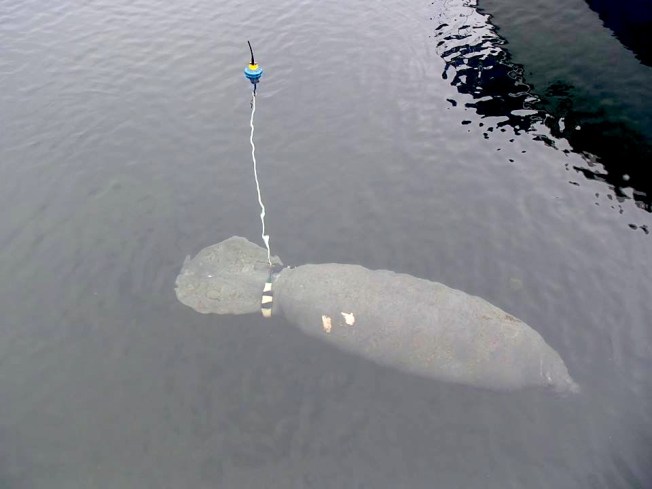
Georgie (sub-adult female) Last seen in Casuarina, Abaco 9th July, 2015 Key feature – 2 pink scars on the right posterior of her body

Randy (sub-adult male) Last sighted in Hope Town August 12th, 2015 Key feature – triangle cut on right side of paddle
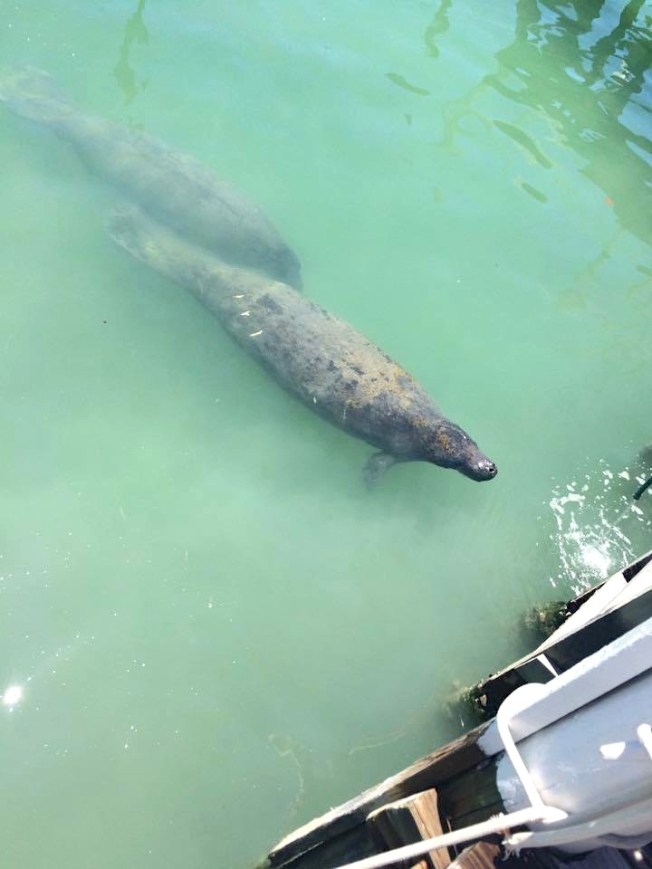
Unknown (adult, presumed female) with Randy Last seen in Hope Town August 12th, 2015 Key feature – 3 prop scars on the posterior right side of body
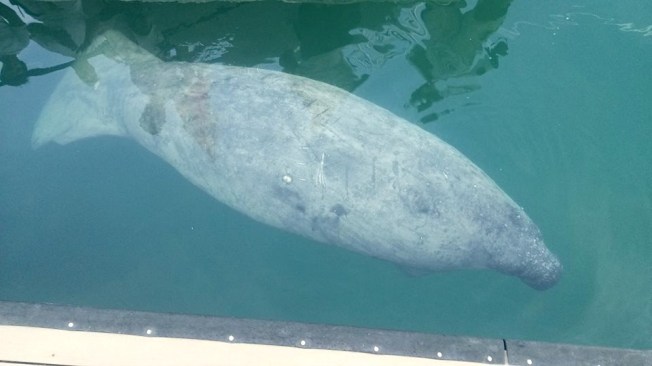
Blackbeard (adult male) Last seen in Lyford Cay August 13th, 2015 Key features – triangle cut on right side of paddle (similar to Randy’s); oval scar on centre of paddle; three prop scars on the back and linear scar

Kong (adult male) Last seen in Great Harbour Cay Marina, February 25th, 2015 Key feature – triangle cut on the left side of paddle; linear scar across the back; oval scar on the back near paddle

J.J. (sub-adult female) Last seen in Great Harbour Cay Marina, Berry Islands, February 25th, 2015 Key feature – 3 small semi-circular cuts out of paddle at the very end
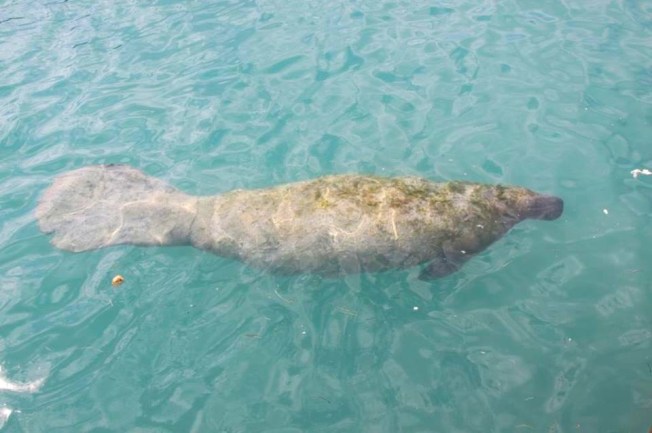
Rita (adult female) Last seen 23rd March, 2014 Hawks Nest Marine, Cat Island Key feature – Large triangle cut on right side of paddle; two small triangular cuts side by side forming a “w” on the left side of paddle
You may have noticed that several of the manatees shown carry scars attributable to prop wounds. Almost all carry injuries of some sort. Because manatees are slow, gentle, inquisitive and trusting creatures, they are especially vulnerable in harbour areas for obvious reasons. Elsewhere than the Bahamas, boat-strike is one of the main causes of manatee mortality. The BMMRO recently issued the above advisory notice because of the uncertainty about the rights and wrongs of watering manatees from docks with hoses and feeding them lettuce etc. Overall the message is that, though creatures of wonder, they are better off being admired but left to their own devices. They are adept at finding the fresh water sources they need, and their sea-grass diet is amply provided for. Dependence on humans, however well-meaning, is actually harmful.
The Travelling Mantee’s Favourite Song
RELATED LINKS
Credits: first and foremost, Felice Leanne Knowles; also BMMRO, Charlotte, & Diane for permission to make free with their material and photos from the get-go; any other photographers of the manatees shown and posted via BMMRO / FLK (Cha Boyce, Jessica Mullen,Otis Wilhoyte I think, maybe others…)
The Bahamas Marine Mammal Research Organisation (BMMRO) has its HQ at Sandy Point, Abaco. We recently went out in their research boat, a RHIB, to spend an unforgettable day with Blainville’s beaked whales and bottlenose dolphins. I posted some of the dolphins HERE; and a two-part beaked whale post is a work in progress.
Male Blainville’s beaked whale with its extraordinary barnacle-encrusted teeth that protrude upwards from its lower jaw. The prominent beak is plainly visible. Sighted off the south-west point of Abaco during our second encounter with a group of these whales – the only male we saw that day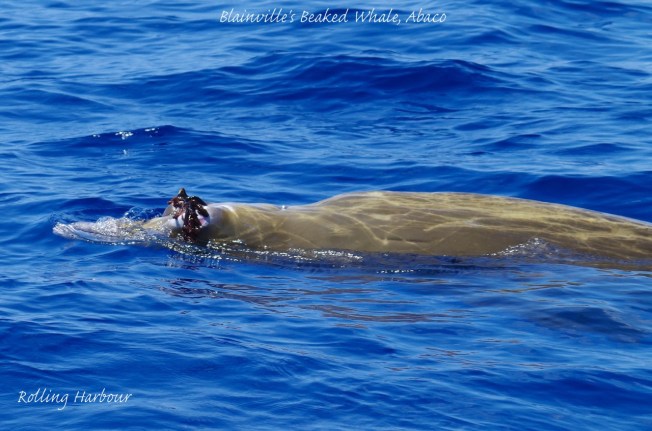
Abaco waters are ideal for marine mammals, especially off the southern shores where the walls of the Great Bahama Canyon drop vertiginously down from the shallow coastal waters to depths of up to 3 miles below. This is one of the deepest ocean canyons in the world. The area provides a rich source of food and nutrients for the whales and dolphins and many different species are regularly sighted there, from huge sperm whales to small pilot whales (including plenty of species I had never heard of before).
As the name suggests, the BMMRO’s remit extends far beyond Abaco. The researchers often spend time exploring and recording cetaceans in other Bahamian waters. For the last few weeks the team have been off Andros and have encountered quite a few target species. I have included a selection below taken within the last month to illustrate the importance of the area for a remarkable assortment of wonderful whales and dolphins.
On board the research vessel, every sighting is recorded in detail – where possible by species, numbers, ages, sexes, and individual identifying characteristics. Thus ‘SW34’ may have a damaged fluke, whereas ‘RD49’ may have a long scar on its back.
The research boat is equipped with sound devices which, when the microphone is immersed, are capable of picking up whale or dolphin sounds from a considerable distance. It’s astounding to be able to listen in ‘live’ to the wide assortment of clicks and whistles produced as the creatures communicate with each other. The recorded sound patterns are studied and can often be matched to enable an individual animal to be identified.
Other work, including photography, is done underwater. Perhaps the most intriguing aspect is the collection of poop specimens, from which a great deal can be ascertained about the diet and health of an individual animal. I wrote about this task and the methods used a while ago in ‘FAMILIAR FECES‘.
I’ll be writing more about whales soon. Meanwhile, here’s a short BMMRO video of a large group of melon-headed males. At the start, you can clearly hear communication sounds between them.
Credits: Charlotte & Diane of the BMMRO for taking us out with them and for all the photos except the male Blainville’s beaked whale (mine, for once!)

“STOP THE CAR!” The shout was embarrassingly loud, amplified by being yelled inside a vehicle. Loud, because it seemed to emanate from very close indeed to my ear. Embarrassing, because it appeared to come out of my own mouth. Good grief! It was me. And I’d seen White Ibises. There they were, 2 adults and 2 juveniles, strolling and feeding their way across an open grassy area right in the middle of Sandy Point, as casual as you please.
So I leapt out of the car (it had conveniently and fortunately stopped by this stage), remembered to remove the lens cap for once, and took some photos. Unfortunately we had driven slightly past them which inevitably increased the risk of bird-butt shots (as the birds were moving away from me) to add to my already impressive ‘aves-ass’ collection
The reason for the excitement was that the White Ibis is classed on Abaco as a ‘WR4‘, that is to say a Winter Resident that is both uncommon to rare and irregularly reported. Some years, maybe none will be seen at all. When I was collecting the images – hundreds and hundreds of them – for THE BIRDS OF ABACO, I rejected any that had not actually been taken on Abaco. That was part of the point of the enterprise, to showcase Abaco’s birds, not “birds from other islands that you may also encounter on Abaco”. So although we had some wonderful White Ibis pics from Nassau, they were ineligible for the book…
We ended with just the one, taken by Kasia Reid at the Treasure Cay Golf course ponds. In the course of the 16 months it took to produce the book, we never obtained another Abaco White Ibis photo, which meant that Kasia’s image did not qualify for a spread and sadly had to be relegated to the supplement… (bird 159 on page 262!). Here it is.
Meanwhile, returning swiftly to Sandy Point, the 4 Ibises (Ibi?) were working their way slowly and systematically over the greenery, picking through it for morsels of food.
Then they were gone, and I got back into the car feeling that I had seen something special. I may have been the only occupant who felt that way, but such is life. For all I know, the birds may have been there for weeks. Or forever. But I have never seen them there before, nor seen reports of them. The sighting further confirms the excellence of Sandy Point as a birding location on land, shoreline and out to sea.
And then it was off to the legendary Nancy’s for lunch (fresh snapper, Kalik). Here are some of the Ibi (that sounds a much better plural) that had to be ruled out of the book for being non-Abaconian.
THE SALON DES REFUSÉS OF THE NASSAU EUDOCIMUS ALBUS
Credits: RH, Kasia Reid, Tony Hepburn, Woody Bracey
Sometimes things happen that completely take my breath away. Here is one of those moments, from our recent trip with Charlotte and Diane in the BMMRO research boat. As we returned from whale-watching to base in Sandy Point and moved from the deep dark ocean to the bright blue shallows, we encountered a group of bottlenose dolphins. You can see my recent post featuring some of the adults HERE. That was exciting enough, as they played around the boat. Then another participant appeared…
Notice the dark area behind the adult dolphin… 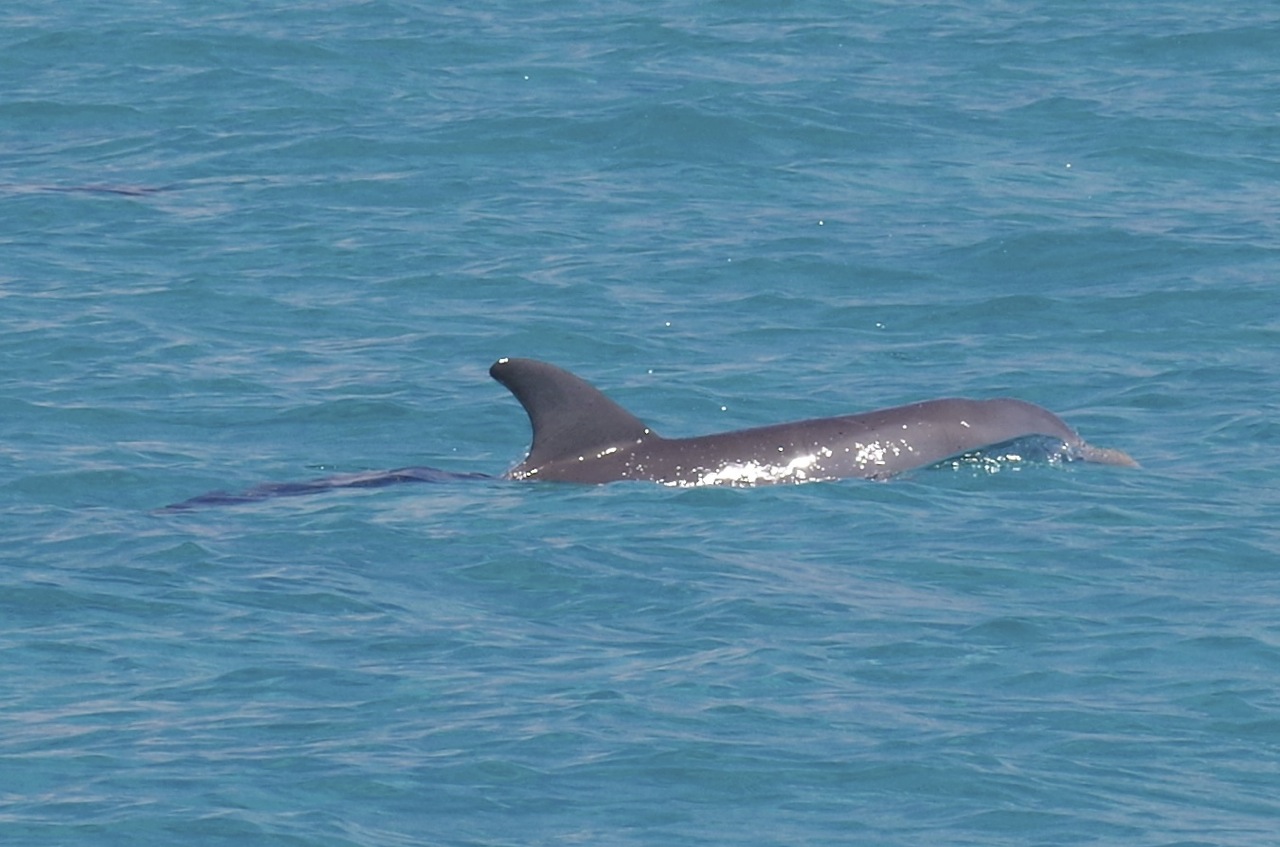
…which soon separated into a small dark splashing creature with its own fin cutting the waves…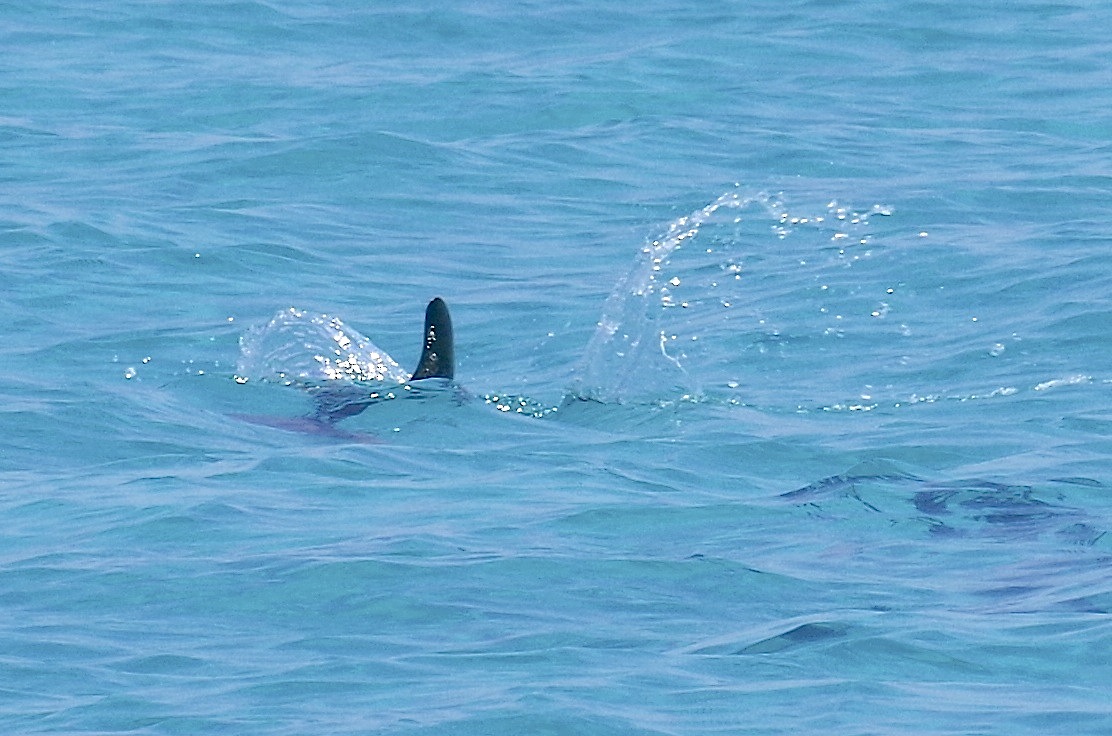
…and next seen keeping pace with its parent
The sharp line between the light and the dark sea is where the sandy shallows abruptly give way to the deep waters of the Grand Bahama Canyon, a massive trench up to 2.5 miles deep with almost vertical cliff walls to the depths in some places
There were less active and splashy moments as the pair swam around together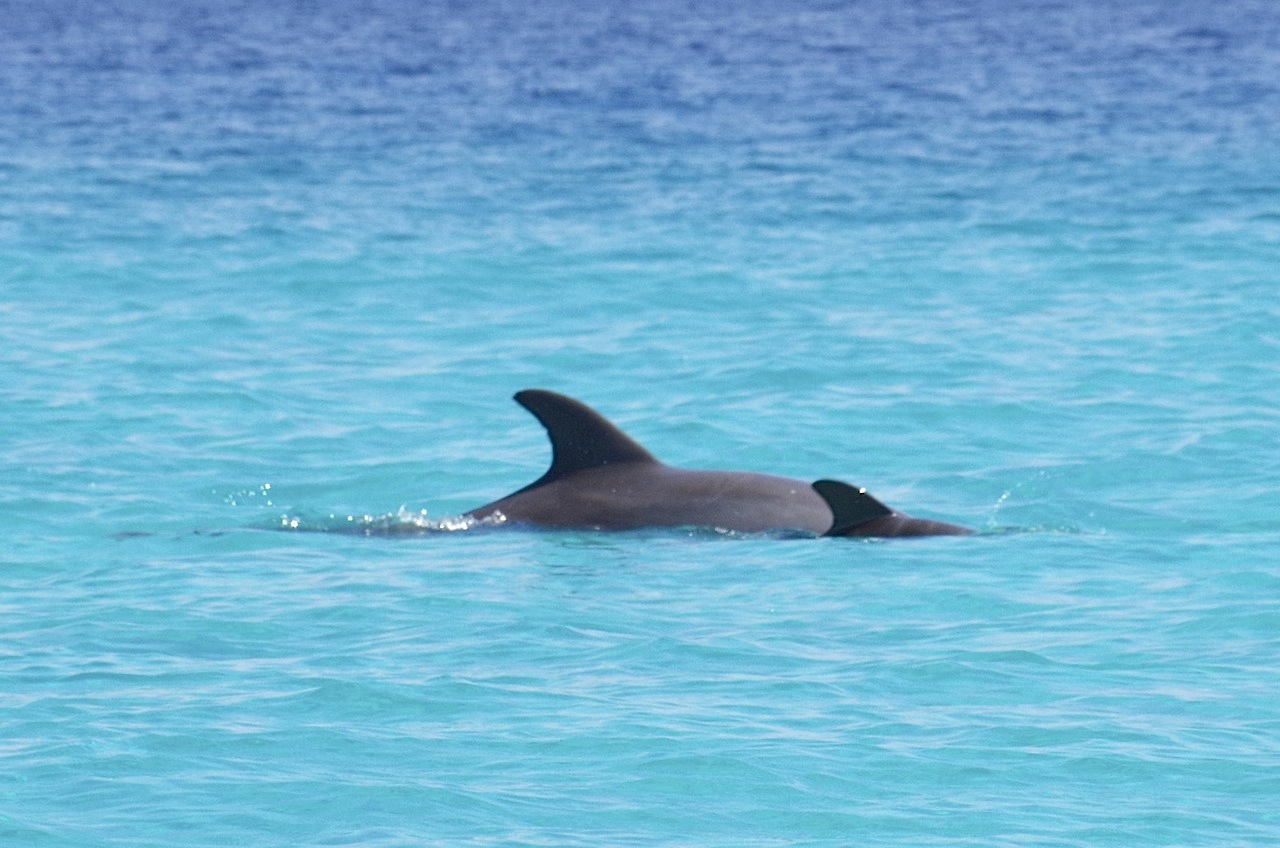
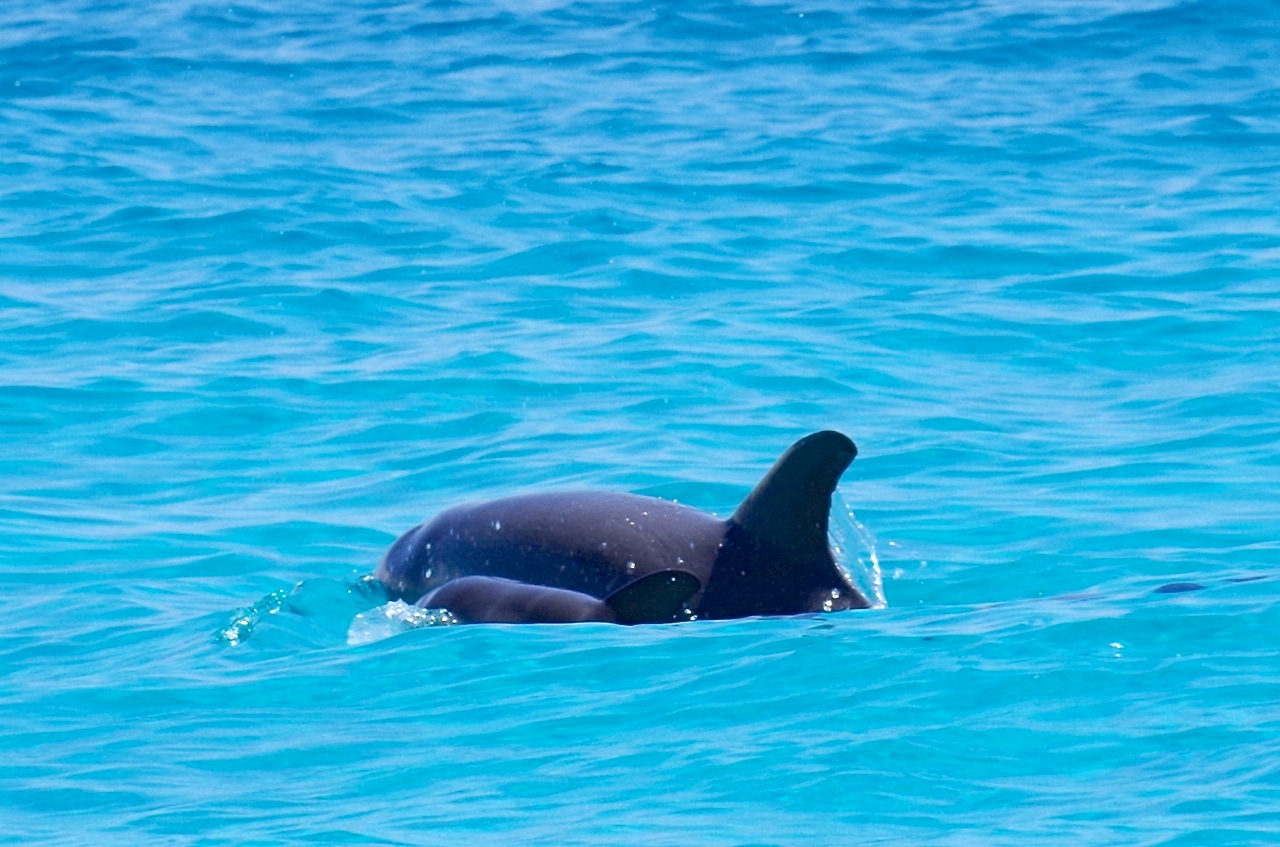
Then it was back to doing what they like best…

Then some more restful moments…
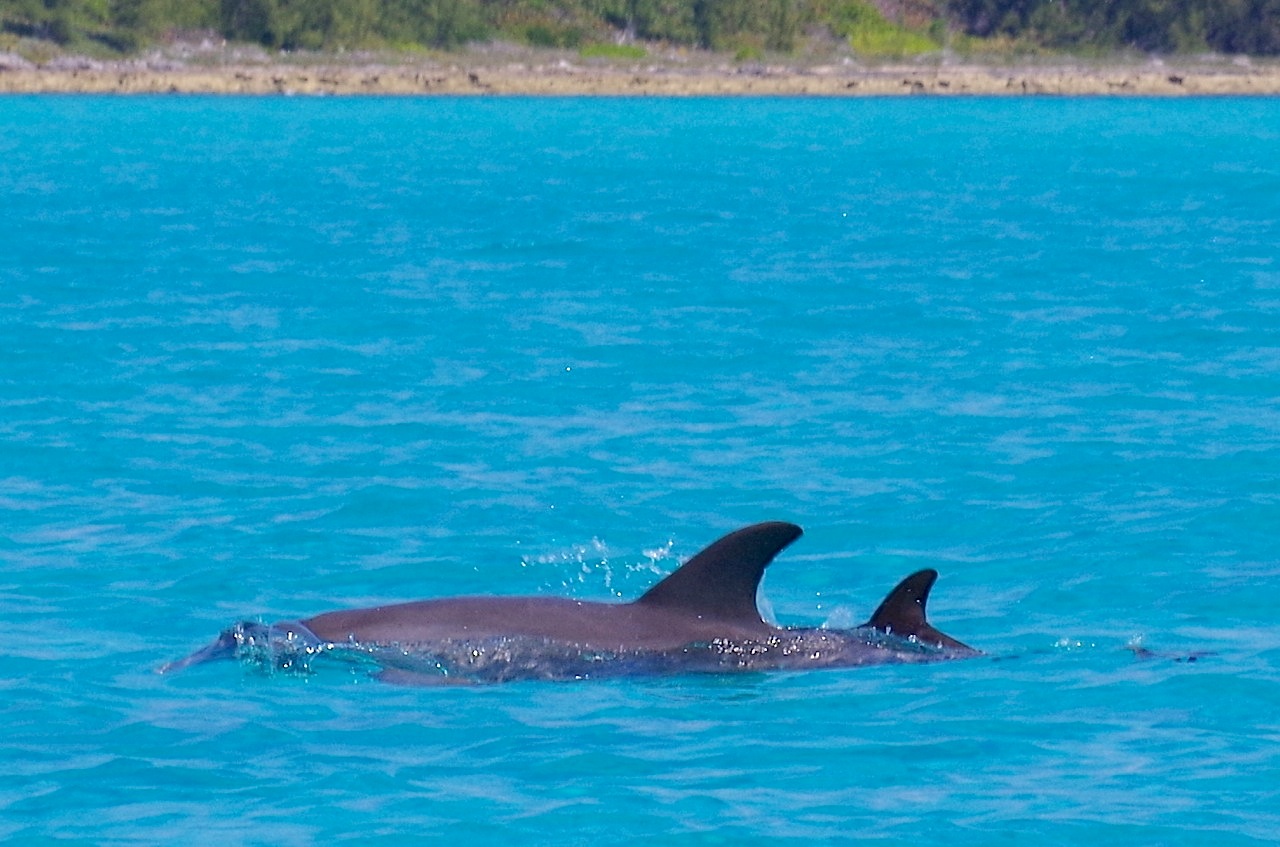
And finally the pair moved away. On the far horizon, the Massive Mickey Mouse Cruise ship moored at ‘Disney’s Castaway Cay’ (formerly the sober-sounding Gorda Cay), where you can be a Pirate of the Caribbean. Or anyway a very happy Tourist. The choice is yours. Would you like fries with that?
And looking out to sea from the cheerful place that is Castaway Cay, I wonder if a small child was wondering “Ok, love Mickey and his Friends – but I’d also really love to see a wild dolphin swimming free…
All photos RH (except Castaway, Wiki). Huge thanks to Charlotte, Diane and Bahamas Marine Mammal Research Organisation BMMRO for a truly wonderful day 
You must be logged in to post a comment.